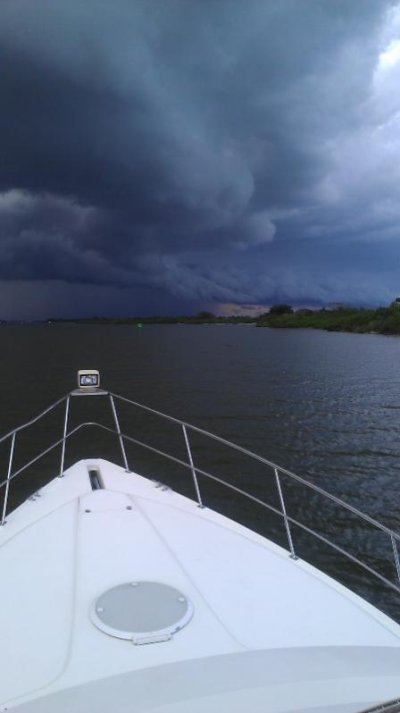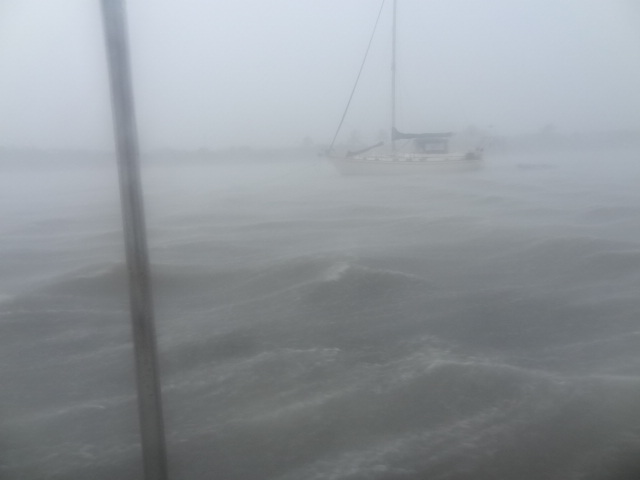We got caught in a doozy of a storm yesterday afternoon and suffered some canvas damage and lost the radar.
We started out about 3:30 for a dinner cruise with GW's 97 year old mother on board. After a nice leisurely cruise up the Columbia we anchored in a fairly well protected cove. There were some other boats in there but it wasn't crowded.
After about an hour we started to fix dinner. We'd been watching a lightening storm that was passing to the south of us and had grown in intensity. There were almost constant lightening strikes coming down and it was exciting to watch. There was a lot of rain failing form the clouds but it was all to the south and west of us. The wind was blowing from the SW so the storm was moving away...or so we thought.
Here's what it looked like before it hit us. Everything was about a mile to the east of us and moving NW
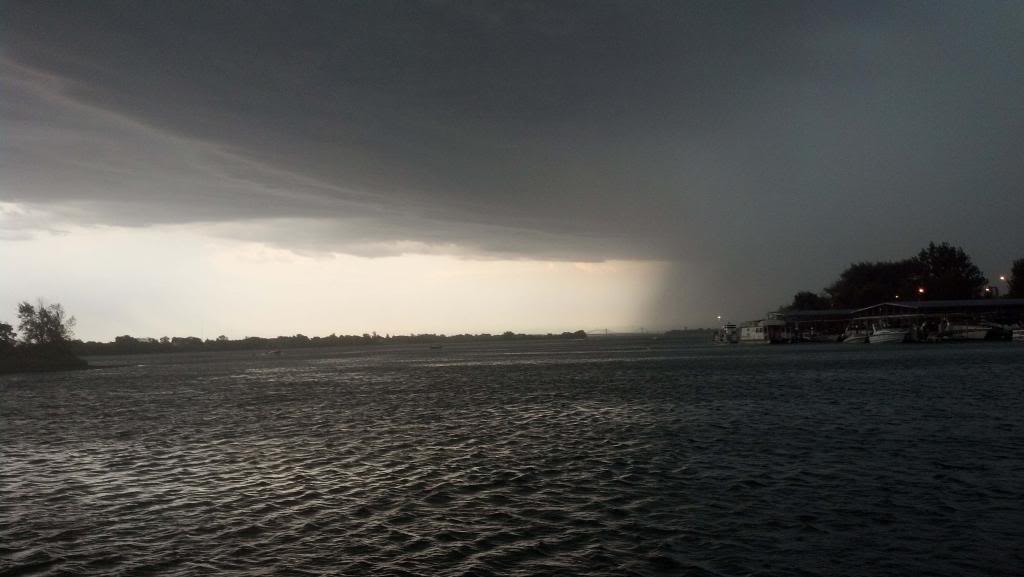 ....
....
We were doing fine and enjoying watching the storm and watching to see if any part of it was headed our way. It wasn't, so I felt fine. Then, all of a sudden there was a lightening strike just to the north of us followed immediately by a loud thunder clap, which indicated that part of the storm was very close. At the same time the wind shifted from the SW to blowing hard out of the north. The boat swung on the anchor but we were OK because it put us more toward the center of the small bay.
Then the wind shifted back to the SW and picked up more (now blowing ~25-30 mph) and we started to drag anchor in the muck bottom. We weren't that far off the shore so I told GW I was going to reposition the boat and drop anchor more in the center of the bay.
I had no sooner fired up the engines and lifted the anchor when the wind REALLY started to blow. This little bay is about 150 yard across and there were white caps forming already. The rain had picked up and was coming down HARD, and blowing sideways.
Over the intercom I told GW we were heading for home and to get things ready down below for getting up on plane. She got everything safely stowed and told me when she was ready. I turned on the radar as soon as I had decided to get underway because visibility had dropped to less than a hundred yards.
I turned to the east to head out of the bay and down the Columbia when we were hit by a huge gust on the stbd side of the boat. It ripped the top bimini loose from the plastic channel that holds it in place and tore out one of the side windows. When that gust hit the boat it tilted the boat about 10-15 degrees to port and held it there a few seconds before it passed by and the boat righted itself.
I pretty much ignored the no-wake speed so I could get out of that shallow cove, traveling about 10 kts as I left the area. As I was leaving the no-wake zone the radar timed in so I flipped it to transmit mode and it quickly picked up a boat about 1/2 mile away that was headed our direction. I couldn't see the boat but did steer to avoid it.
As I got out of the no-wake zone the rain was really coming down hard, the thunder and lightening were very close, and it was really blowing. GW brought me up a foul weather jacket because I didn't have a shirt on and the rain stung when it hit.
I got on plane and headed back to the marina. As we were cruising along I had one eye on the radar and one eye trying to peer through the heavy rain. About half way back to our marina there was a lightening strike on shore just off our stbd side. When it hit I was watching the radar screen, which lit up very brightly then went black.
We made it back to the slip without any further problem. By the time we got back there the storm has moved on and the wind had almost completely died. After we got secured in the slip I had a chance to take a look at the bimini. Here's what it looks like now....
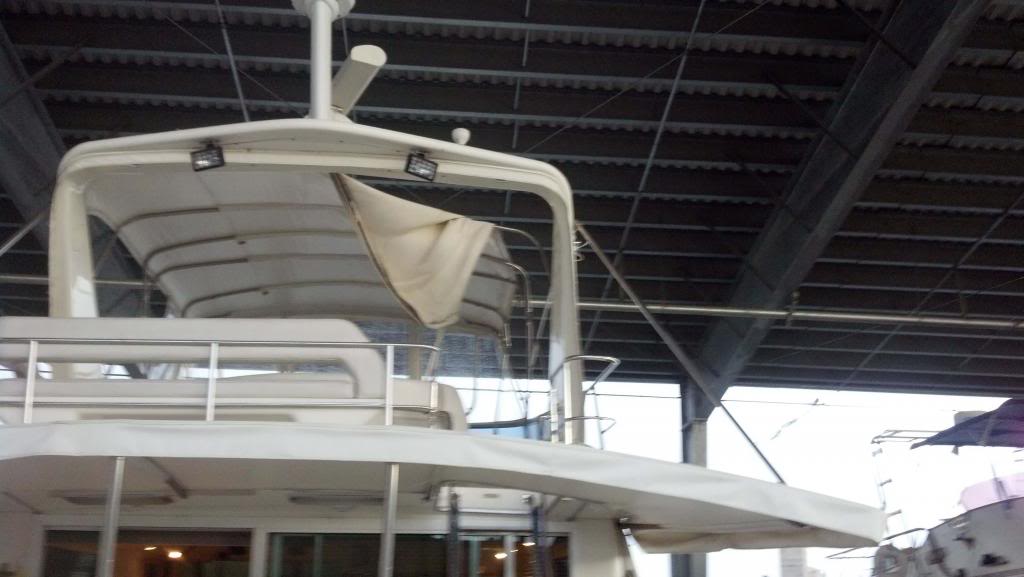

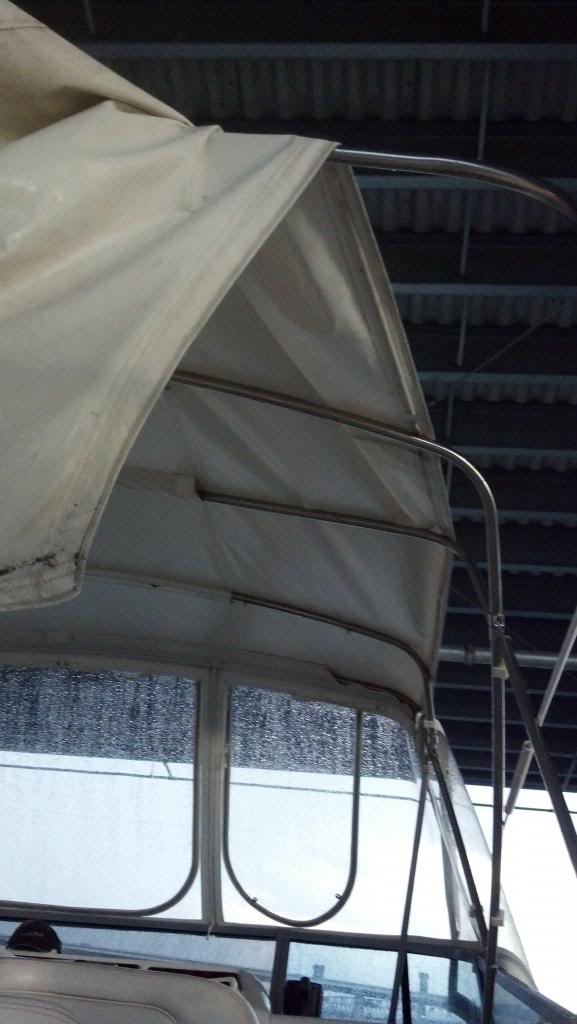
I'm glad we were able to get back relatively unscathed, but I bet my insurance guy isn't going to like my phone call this morning.
We started out about 3:30 for a dinner cruise with GW's 97 year old mother on board. After a nice leisurely cruise up the Columbia we anchored in a fairly well protected cove. There were some other boats in there but it wasn't crowded.
After about an hour we started to fix dinner. We'd been watching a lightening storm that was passing to the south of us and had grown in intensity. There were almost constant lightening strikes coming down and it was exciting to watch. There was a lot of rain failing form the clouds but it was all to the south and west of us. The wind was blowing from the SW so the storm was moving away...or so we thought.
Here's what it looked like before it hit us. Everything was about a mile to the east of us and moving NW

We were doing fine and enjoying watching the storm and watching to see if any part of it was headed our way. It wasn't, so I felt fine. Then, all of a sudden there was a lightening strike just to the north of us followed immediately by a loud thunder clap, which indicated that part of the storm was very close. At the same time the wind shifted from the SW to blowing hard out of the north. The boat swung on the anchor but we were OK because it put us more toward the center of the small bay.
Then the wind shifted back to the SW and picked up more (now blowing ~25-30 mph) and we started to drag anchor in the muck bottom. We weren't that far off the shore so I told GW I was going to reposition the boat and drop anchor more in the center of the bay.
I had no sooner fired up the engines and lifted the anchor when the wind REALLY started to blow. This little bay is about 150 yard across and there were white caps forming already. The rain had picked up and was coming down HARD, and blowing sideways.
Over the intercom I told GW we were heading for home and to get things ready down below for getting up on plane. She got everything safely stowed and told me when she was ready. I turned on the radar as soon as I had decided to get underway because visibility had dropped to less than a hundred yards.
I turned to the east to head out of the bay and down the Columbia when we were hit by a huge gust on the stbd side of the boat. It ripped the top bimini loose from the plastic channel that holds it in place and tore out one of the side windows. When that gust hit the boat it tilted the boat about 10-15 degrees to port and held it there a few seconds before it passed by and the boat righted itself.
I pretty much ignored the no-wake speed so I could get out of that shallow cove, traveling about 10 kts as I left the area. As I was leaving the no-wake zone the radar timed in so I flipped it to transmit mode and it quickly picked up a boat about 1/2 mile away that was headed our direction. I couldn't see the boat but did steer to avoid it.
As I got out of the no-wake zone the rain was really coming down hard, the thunder and lightening were very close, and it was really blowing. GW brought me up a foul weather jacket because I didn't have a shirt on and the rain stung when it hit.
I got on plane and headed back to the marina. As we were cruising along I had one eye on the radar and one eye trying to peer through the heavy rain. About half way back to our marina there was a lightening strike on shore just off our stbd side. When it hit I was watching the radar screen, which lit up very brightly then went black.
We made it back to the slip without any further problem. By the time we got back there the storm has moved on and the wind had almost completely died. After we got secured in the slip I had a chance to take a look at the bimini. Here's what it looks like now....



I'm glad we were able to get back relatively unscathed, but I bet my insurance guy isn't going to like my phone call this morning.


